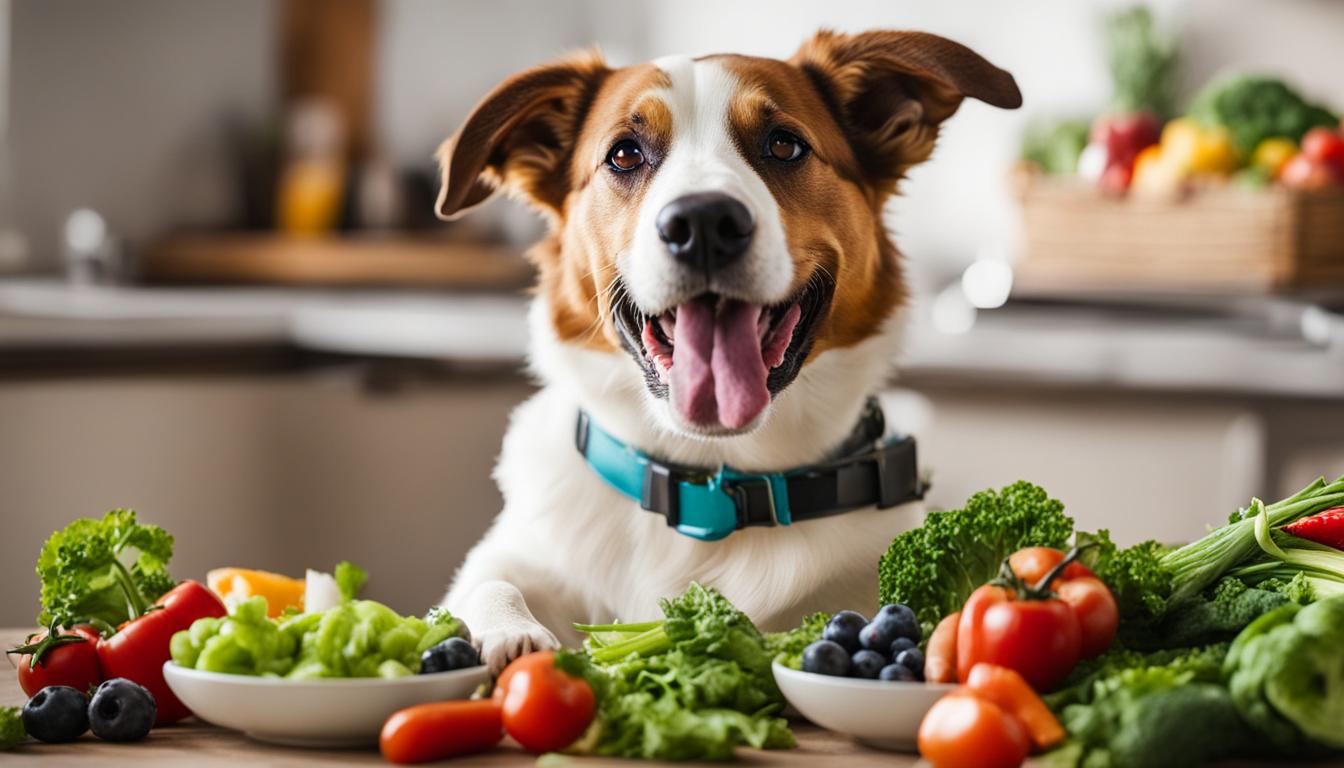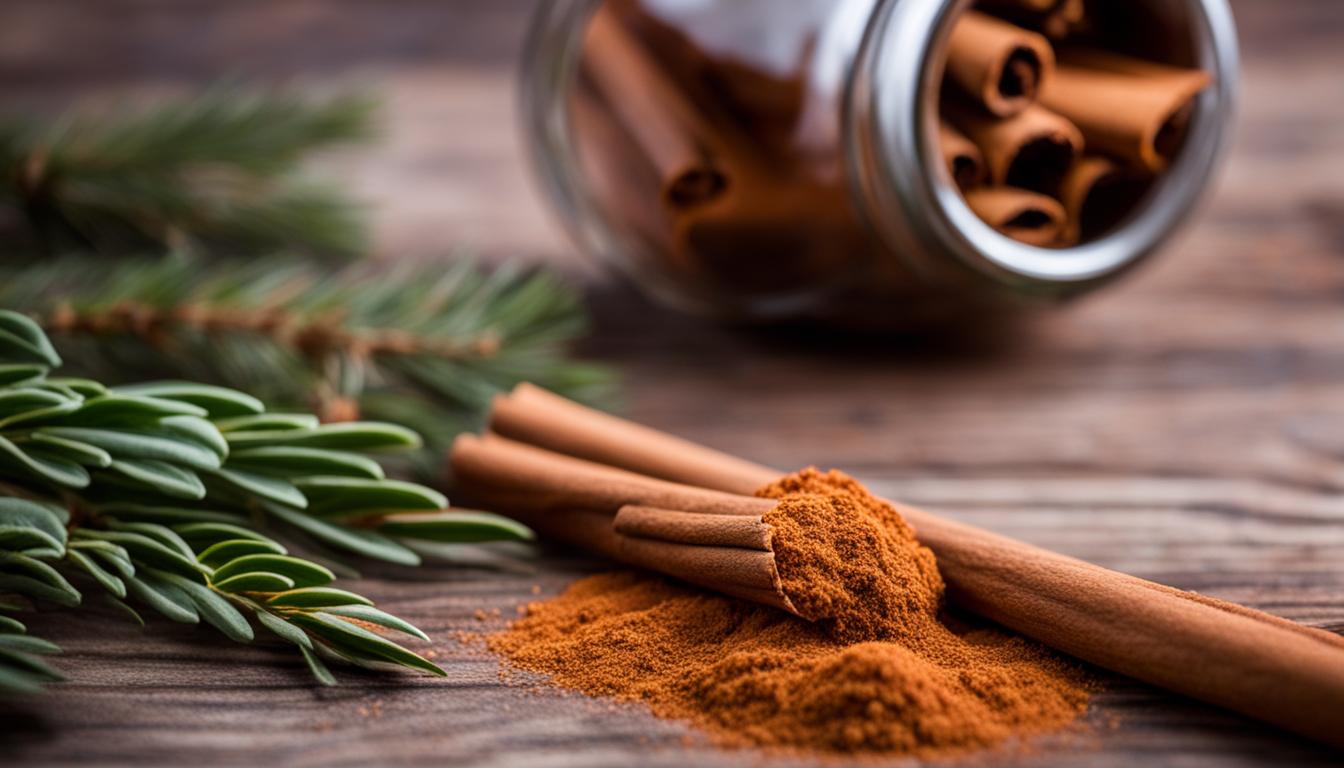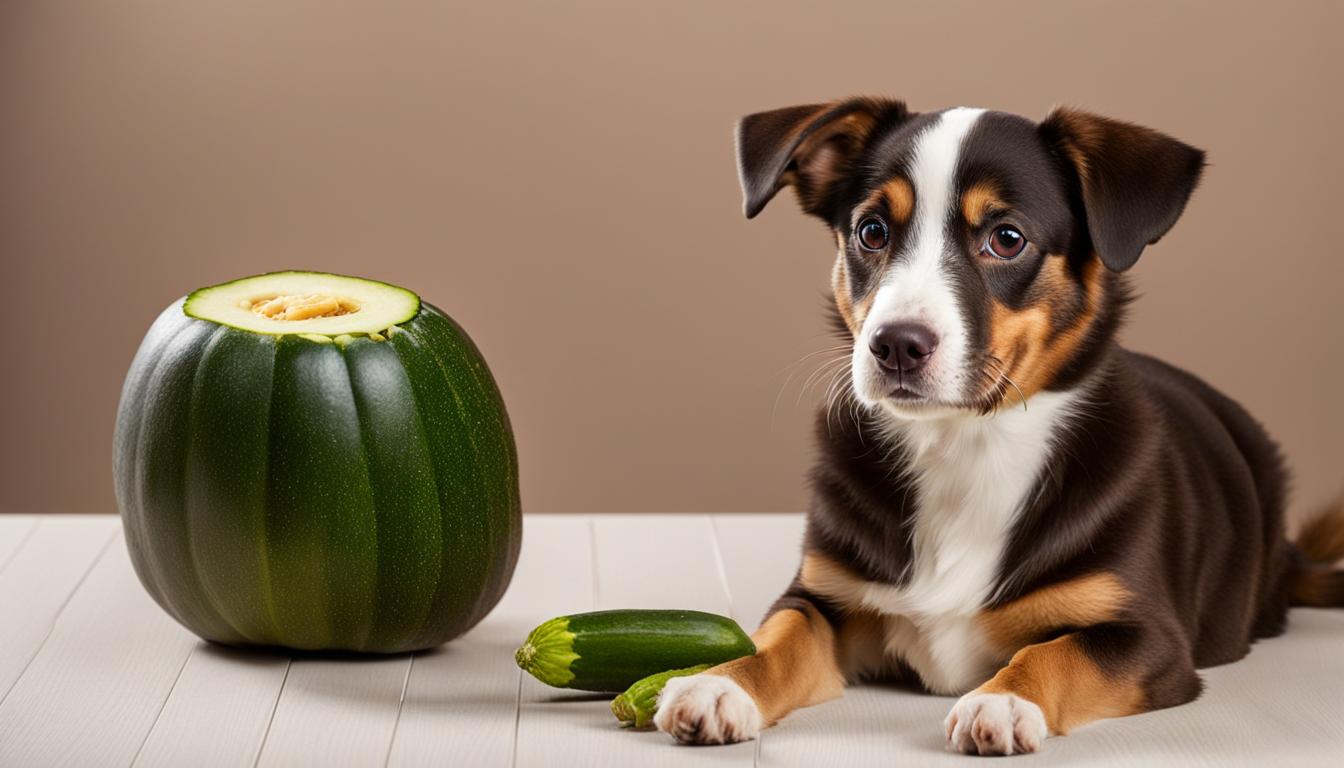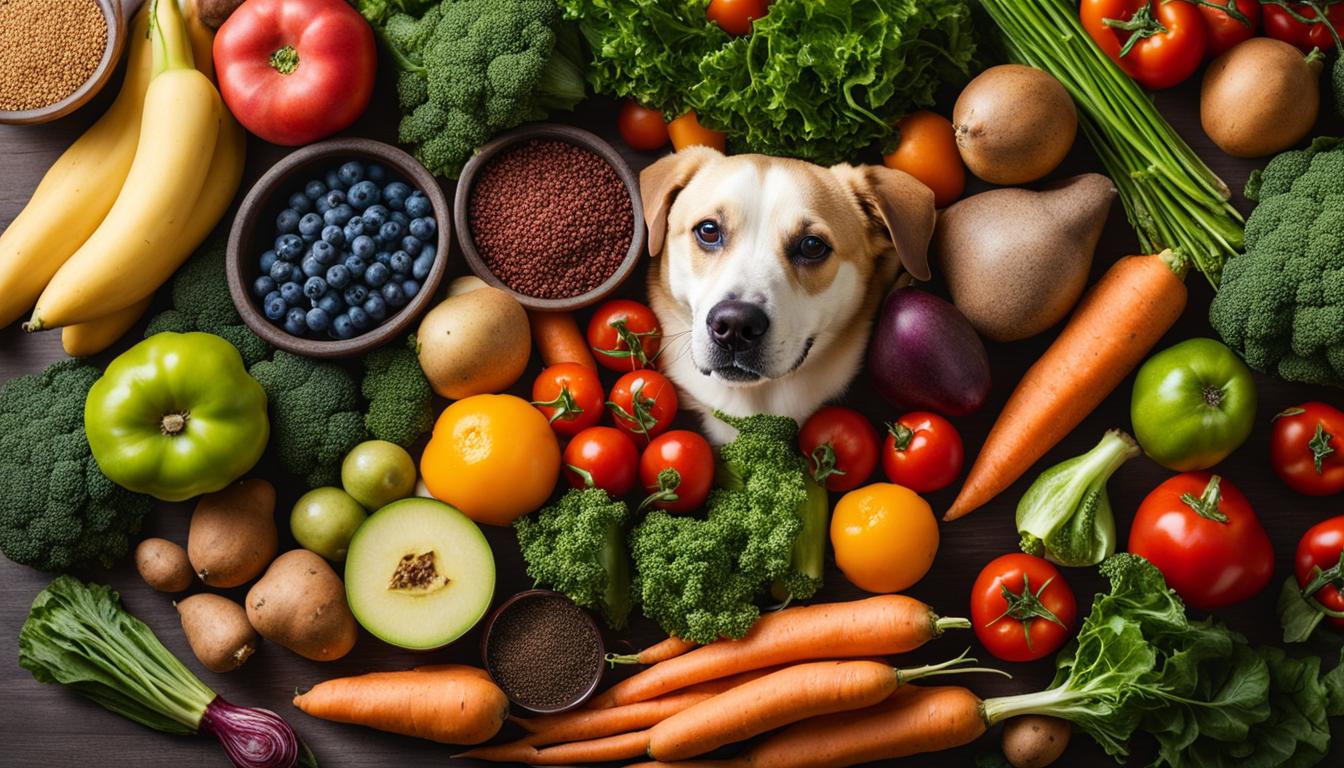Is your furry friend suffering from pancreatitis? Don’t worry, we’ve got you covered! In this article, we’ll explore the role of low-fat diets in managing dog pancreatitis and provide valuable insights into pancreatitis-friendly dog foods. By understanding the importance of diet in pancreatitis treatment, you can help your beloved pet on their road to recovery.
Key Takeaways:
- Low-fat diets are crucial for managing pancreatitis in dogs.
- Pancreatitis can be caused by various factors, including high-fat diets.
- Nutritional requirements vary based on factors such as body condition, life stage, and health status.
- There are different food options available, including commercial dog foods and homemade diets.
- Feeding low-fat diets helps minimize pancreatic inflammation and promotes recovery.
Understanding Pancreatitis and Its Causes
Pancreatitis is a condition characterized by inflammation of the pancreas, a vital organ that produces enzymes and hormones essential for digestion and metabolism. It is important to understand what exactly pancreatitis is and what factors can contribute to its development in dogs.
Pancreatitis can be caused by various factors, including certain medications, infections, metabolic disorders, obesity, and dietary indiscretion. High-fat diets, in particular, can trigger acute pancreatitis, while chronic pancreatitis may develop over time due to ongoing inflammation. It is crucial to identify the underlying causes of pancreatitis to effectively manage and prevent its recurrence.
The clinical signs of pancreatitis can include vomiting, anorexia, abdominal pain, and dehydration. If you suspect that your dog may be suffering from pancreatitis, it is important to seek veterinary care for a proper diagnosis and treatment plan. Identifying the root cause of pancreatitis will help guide the appropriate dietary adjustments and lifestyle changes needed to support your dog’s health.
Possible Causes of Pancreatitis in Dogs:
- Dietary Indiscretion: Consumption of fatty or spicy foods
- Obesity: Excess body weight can strain the pancreas
- Certain Medications: Some medications may contribute to pancreatitis
- Infections: Bacterial or viral infections can trigger inflammation
- Metabolic Disorders: Conditions like diabetes or hypothyroidism
| Possible Causes of Pancreatitis in Dogs | Additional Information |
|---|---|
| Dietary Indiscretion | Consumption of fatty or spicy foods |
| Obesity | Excess body weight can strain the pancreas |
| Certain Medications | Some medications may contribute to pancreatitis |
| Infections | Bacterial or viral infections can trigger inflammation |
| Metabolic Disorders | Conditions like diabetes or hypothyroidism |
Nutritional Requirements for Dogs with Pancreatitis
Dogs with pancreatitis have specific nutritional requirements that need to be addressed in their diet. These requirements are based on factors such as the dog’s body condition, life stage, and overall health status.
Body condition scoring: One way to determine a dog’s nutritional needs is through body condition scoring. This assessment helps determine whether a dog needs fewer or more calories in their diet. Overweight dogs are more prone to pancreatitis, so weight management is crucial in their nutritional plan.
Life stage and health status: Puppies have higher energy and protein requirements, while senior dogs may require lower calorie and fat diets. Dogs with other health conditions may also have specific dietary needs that need to be considered. Consulting with a veterinarian is important to ensure the dog’s diet meets their individual requirements.
Low-fat and high-fiber diets: Dogs with a higher risk of pancreatitis require special diets that are low in fat and high in fiber. These diets help reduce pancreatic inflammation and provide adequate nutrition for the dog’s recovery. It is important to select dog foods that are specifically formulated for pancreatitis patients and meet the nutritional requirements outlined by veterinary professionals.
The Benefits of Proper Nutrition for Dogs with Pancreatitis
Proper nutrition plays a vital role in managing pancreatitis in dogs. Feeding a low-fat and high-fiber diet helps minimize pancreatic stimulation and inflammation. By selecting the right food and following a veterinarian’s guidance, dog owners can provide their pets with the optimal nutrition needed for pancreatitis management.
Feeding appropriate diets can help prevent flare-ups and complications associated with pancreatitis. It also supports the dog’s overall well-being and helps in their recovery process. Ensuring that dogs with pancreatitis receive proper nutrition is crucial for their long-term health and quality of life.
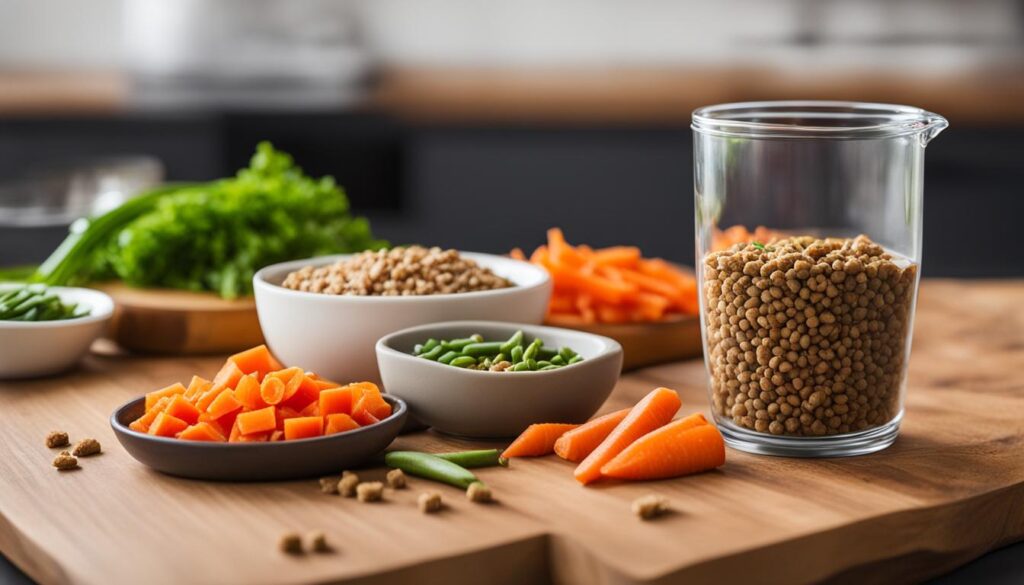
Ultimately, by understanding the nutritional requirements for dogs with pancreatitis, pet owners can make informed decisions about their pet’s diet. Consultation with a veterinarian, adherence to low-fat and high-fiber diets, and regular monitoring of the dog’s condition can significantly improve their health outcomes and overall quality of life.
Comparing Food Options for Dogs with Pancreatitis
When it comes to managing pancreatitis in dogs, choosing the right food is crucial. There are several options available, including commercial dog foods, prescription diets, and homemade meals. Each option has its own advantages and considerations to keep in mind.
Commercial Dog Foods
Commercial dog foods are widely available and come in a range of brands and formulations. They can vary from budget-friendly options to high-quality, premium foods. When selecting commercial dog foods for dogs with pancreatitis, look for options that are specifically labeled as low-fat or designed for gastrointestinal health. These foods are formulated to meet the unique nutritional needs of dogs with pancreatitis.
Prescription Foods
If your veterinarian recommends a prescription diet for your dog with pancreatitis, it’s important to follow their guidance. Prescription foods are formulated with specific ingredients to support digestive health and manage pancreatitis symptoms. These diets often have lower fat content and higher fiber content compared to regular commercial dog foods.
Homemade Diets
Some pet owners prefer to prepare homemade meals for their dogs with pancreatitis. Homemade diets can give you more control over the ingredients and cooking methods used. However, it’s crucial to work closely with a veterinary nutritionist to ensure your homemade diet is nutritionally balanced and meets your dog’s specific needs. A veterinary nutritionist can help you determine the right balance of nutrients and recommend appropriate ingredients for your dog’s homemade meals.
| Food Option | Advantages | Considerations |
|---|---|---|
| Commercial Dog Foods | Widely available, various brands and formulations | Read labels carefully, ensure they are low-fat and suitable for pancreatitis |
| Prescription Foods | Formulated for gastrointestinal health, lower fat content | May be more expensive, require a prescription from a veterinarian |
| Homemade Diets | More control over ingredients and cooking methods | Requires guidance from a veterinary nutritionist, ensuring nutritional balance |
Ultimately, the choice of food for your dog with pancreatitis will depend on their individual needs and your preferences. It’s essential to consult with your veterinarian and follow their recommendations to ensure your dog receives the appropriate nutrition for managing pancreatitis.
Feeding Low-Fat Diets for Pancreatitis: The Key to a Healthier Dog
When it comes to managing pancreatitis in dogs, feeding a low-fat diet is crucial for their health and well-being. By avoiding high-fat foods and prioritizing low-fat options, you can help minimize pancreatic inflammation and support your furry friend’s recovery. But why are low-fat diets so important for dogs with pancreatitis? Let’s take a closer look at the benefits.
Avoiding high-fat foods is essential because they can trigger pancreatic inflammation and worsen the condition. By feeding your dog a low-fat diet, you minimize the stimulation of enzymes that contribute to inflammation. This can help reduce the severity and duration of pancreatitis episodes. So, when selecting food options, remember to read the labels carefully and opt for those with a maximum of 15% fat content on a dry matter basis.
Low-fat diets not only reduce the risk of pancreatitis flare-ups but also provide other health benefits. When you choose low-fat, highly digestible foods for your dog, you support their overall digestive health. These diets are easier on the pancreas, allowing it to function better and improve nutrient absorption. Additionally, low-fat diets can help your dog maintain a healthy weight, which is crucial for preventing pancreatitis in the long run.
So, what kinds of foods are considered safe for dogs with pancreatitis? Boiled chicken, rice, yogurt, and cooked vegetables are low-fat, highly digestible options that can be included in their diet. It’s also important to feed your dog small, frequent meals to avoid overloading the pancreas. By following these dietary guidelines, you can help manage pancreatitis effectively and provide your dog with the nutrition they need for a healthier, happier life.

The Benefits of Low-Fat Diets for Pancreatitis:
- Minimize pancreatic inflammation
- Reduce the severity and duration of pancreatitis episodes
- Support overall digestive health
- Improve nutrient absorption
- Promote a healthy weight
By understanding the importance of feeding low-fat diets to dogs with pancreatitis, you can make informed decisions about their nutrition and maximize their chances of recovery. Consult with your veterinarian to determine the appropriate diet for your dog’s specific needs and follow their guidance closely. With the right diet and care, you can help your furry friend live a happy and healthy life despite pancreatitis.
The Role of Diet in Pancreatitis Treatment and Recovery
During the treatment and recovery of dogs with pancreatitis, diet plays a crucial role in promoting healing and minimizing further complications. While the initial approach may involve fasting to rest the pancreas, recent research suggests that small, frequent meals are more beneficial for the digestive system. Feeding a highly digestible carbohydrate source, such as rice, can help provide energy without overstimulating the pancreas.
Avoiding high-fat foods is essential in pancreatitis management. By maintaining a low-fat, high-fiber diet, the risk of pancreatic inflammation and exacerbation of symptoms can be significantly reduced. It is important to prioritize low-fat options and provide the necessary nutritional support to aid recovery.
In severe cases or if the dog is unable to eat, nutritional support may be necessary. This can include partial parenteral nutrition, total parenteral nutrition, or jejunal tube feeding. These methods ensure that the dog receives essential nutrients while minimizing the workload on the pancreas. The specific approach will depend on the severity of pancreatitis and the overall condition of the dog.
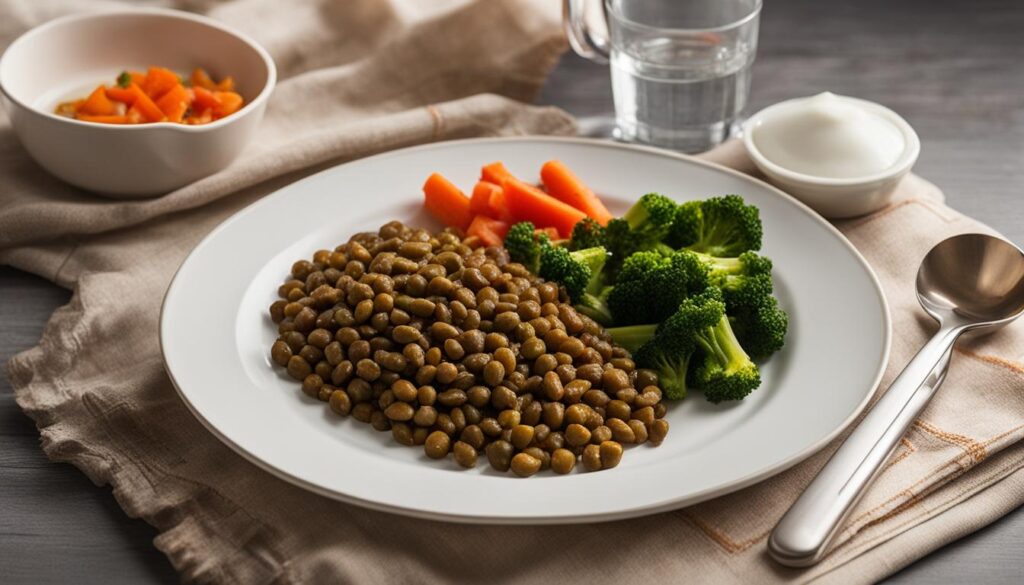
Table: Nutritional Support Options for Dogs with Pancreatitis
| Nutritional Support Method | Description |
|---|---|
| Partial Parenteral Nutrition | Combination of intravenous fluid therapy and enteral feeding to provide partial nutrition. |
| Total Parenteral Nutrition | Complete nutrition provided intravenously when the dog is unable to eat or tolerate enteral feeding. |
| Jejunal Tube Feeding | Direct delivery of liquid nutrition into the small intestine via a tube inserted through the nose or abdominal wall. |
Consulting with a veterinarian is crucial in determining the most appropriate diet and nutritional support for a dog with pancreatitis. The veterinarian will consider the severity of the condition and the dog’s individual needs to develop a tailored treatment plan. By following the recommended diet and providing the necessary support, dog owners can help improve their pet’s prognosis and support a successful recovery.
Selecting the Right Food for Dogs with Pancreatitis
When it comes to managing pancreatitis in dogs, selecting the right food is crucial. A low-fat diet with high digestibility is key to minimizing pancreatic inflammation and supporting your furry friend’s overall health. So, how do you choose the best dog food for pancreatitis?
First and foremost, look for low-fat options that contain a maximum of 15% fat on a dry matter basis. Reading the dog food label and understanding the guaranteed analysis, specifically the fat content, is essential. Opt for commercial dog food brands that prioritize pet nutrition and employ veterinary nutritionists to ensure the highest quality ingredients.
Consulting with your veterinarian is also crucial in selecting the right food for your dog with pancreatitis. They can provide personalized recommendations based on your dog’s specific needs and circumstances. Together, you can determine the most suitable diet plan to manage pancreatitis effectively.
Remember, the goal is to provide a low-fat diet that is highly digestible. This helps to minimize the stimulation of enzymes that can cause inflammation in the pancreas. By choosing the best dog food for pancreatitis and following your veterinarian’s guidance, you can support your furry friend’s journey to better health and wellbeing.
| Key Considerations for Selecting Dog Food for Pancreatitis | Low-Fat Options | High Digestibility |
|---|---|---|
| Benefits |
|
|
| Dietary Requirements |
|
|
| Veterinarian Guidance |
|
|
By prioritizing the well-being of your dog and making informed decisions about their diet, you can play an active role in managing pancreatitis. Choose low-fat, highly digestible dog food options and collaborate with your veterinarian to ensure the best possible outcome for your furry companion.
Conclusion
Proper nutrition is key to managing and aiding in the recovery of dogs with pancreatitis. By following a low-fat diet and making informed choices about their food, you can provide your furry friend with the optimal nutrition they need. A low-fat diet helps reduce inflammation and minimizes pancreatic stimulation, promoting healing and overall wellness.
By selecting the right food, you can avoid exacerbating the condition and ensure your dog receives the essential nutrients they require. Opt for low-fat diets with a maximum of 15% fat on a dry matter basis. Consider commercial dog food brands that prioritize pet nutrition and employ veterinary nutritionists, ensuring you’re making the best choice for your dog’s health.
Remember to consult with your veterinarian for guidance and recommendations regarding your dog’s diet. They will provide you with the necessary information and support to make the best decisions for managing your dog’s pancreatitis. With proper nutrition and care, you can help your furry companion on their journey to recovery and provide them with a better quality of life.
Incorporating a low-fat diet into your dog’s routine has numerous benefits. It not only aids in managing pancreatitis but also supports overall health and wellness. By prioritizing proper nutrition, you’re giving your dog the best chance at a happy, healthy life. So, make the right choices, show them some love through their diet, and watch them thrive!
FAQ
What is pancreatitis?
Pancreatitis is inflammation of the pancreas, an organ responsible for producing enzymes and hormones.
What causes pancreatitis in dogs?
Pancreatitis in dogs can be caused by factors such as certain medications, infections, metabolic disorders, obesity, and dietary indiscretion.
What are the signs of pancreatitis in dogs?
Clinical signs of pancreatitis in dogs include vomiting, anorexia, abdominal pain, and dehydration.
How do I determine the nutritional needs of my dog with pancreatitis?
The nutritional needs of a dog with pancreatitis depend on factors such as body condition, life stage, and overall health. Body condition scoring can help determine the appropriate calorie intake for your dog.
What types of food options are available for dogs with pancreatitis?
There are several food options available, including commercial dog foods, prescription diets, and homemade diets prepared with the guidance of a veterinary nutritionist.
Why is it important to feed a low-fat diet to dogs with pancreatitis?
High-fat foods can exacerbate pancreatitis and trigger inflammation. Feeding a low-fat diet helps minimize pancreatic stimulation and promote recovery.
How does diet play a role in pancreatitis treatment and recovery?
Diet is a crucial component of pancreatitis treatment and recovery. Feeding a low-fat, high-fiber diet helps minimize inflammation and provide essential nutrition for recovery.
How do I select the right food for my dog with pancreatitis?
It is important to consider the fat content and digestibility of the food. Low-fat diets with a maximum of 15% fat are recommended. Consulting with a veterinarian and reading food labels can help in selecting the right food.
What is the importance of proper nutrition for dogs with pancreatitis?
Proper nutrition through low-fat diets is vital in managing pancreatitis in dogs. It supports the healing process and overall well-being of the dog.

